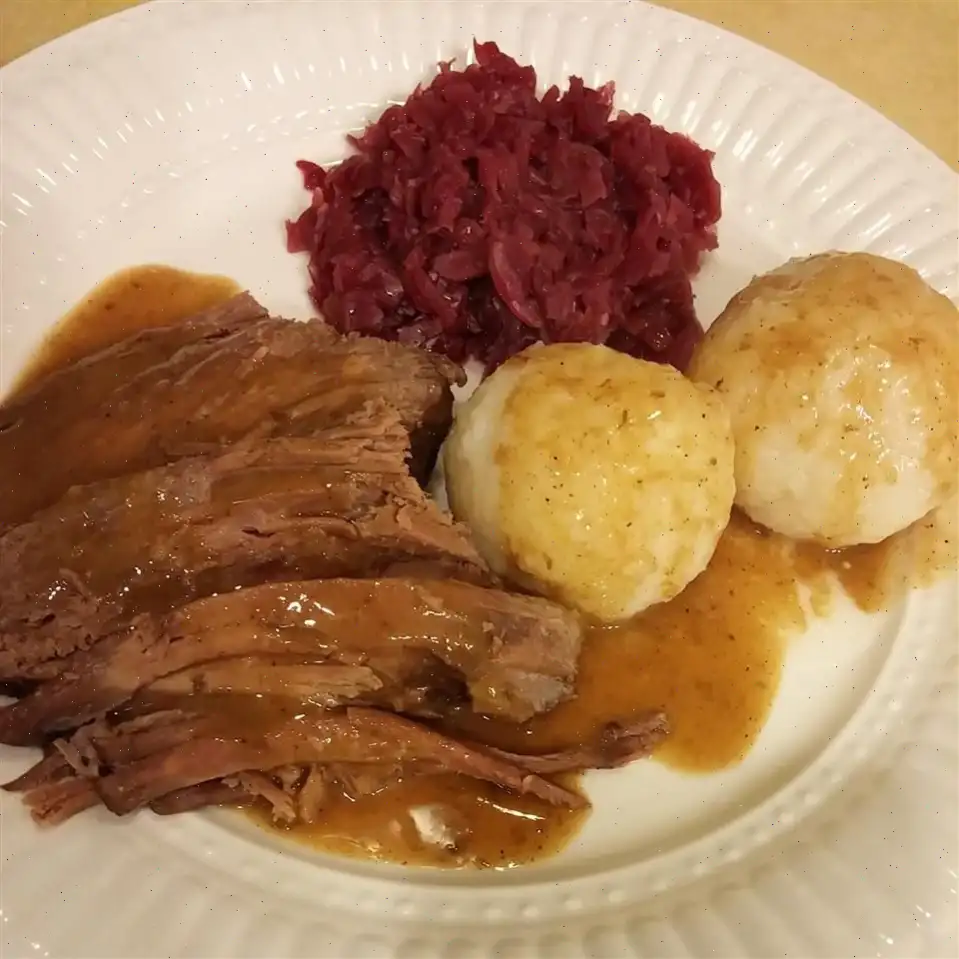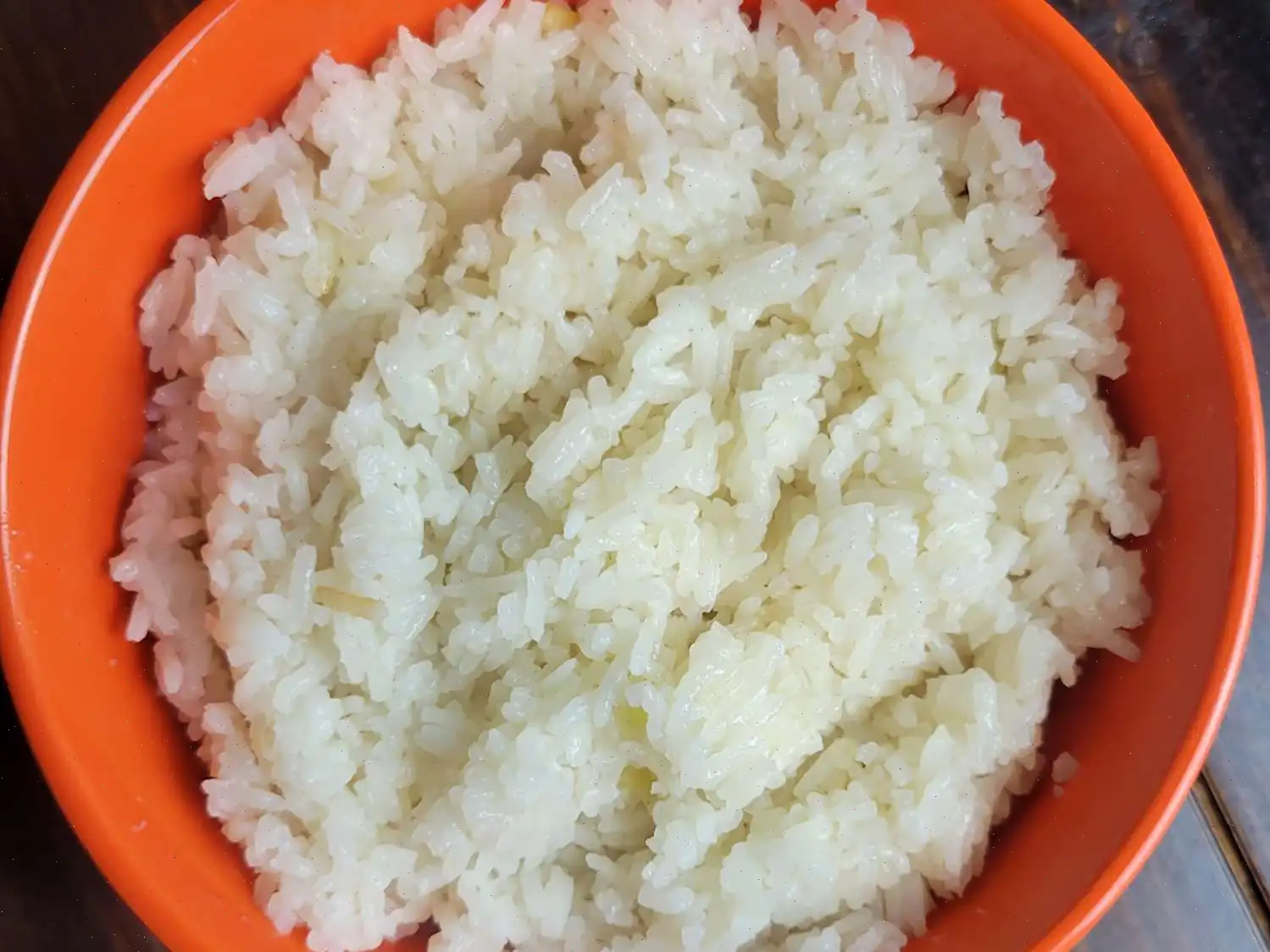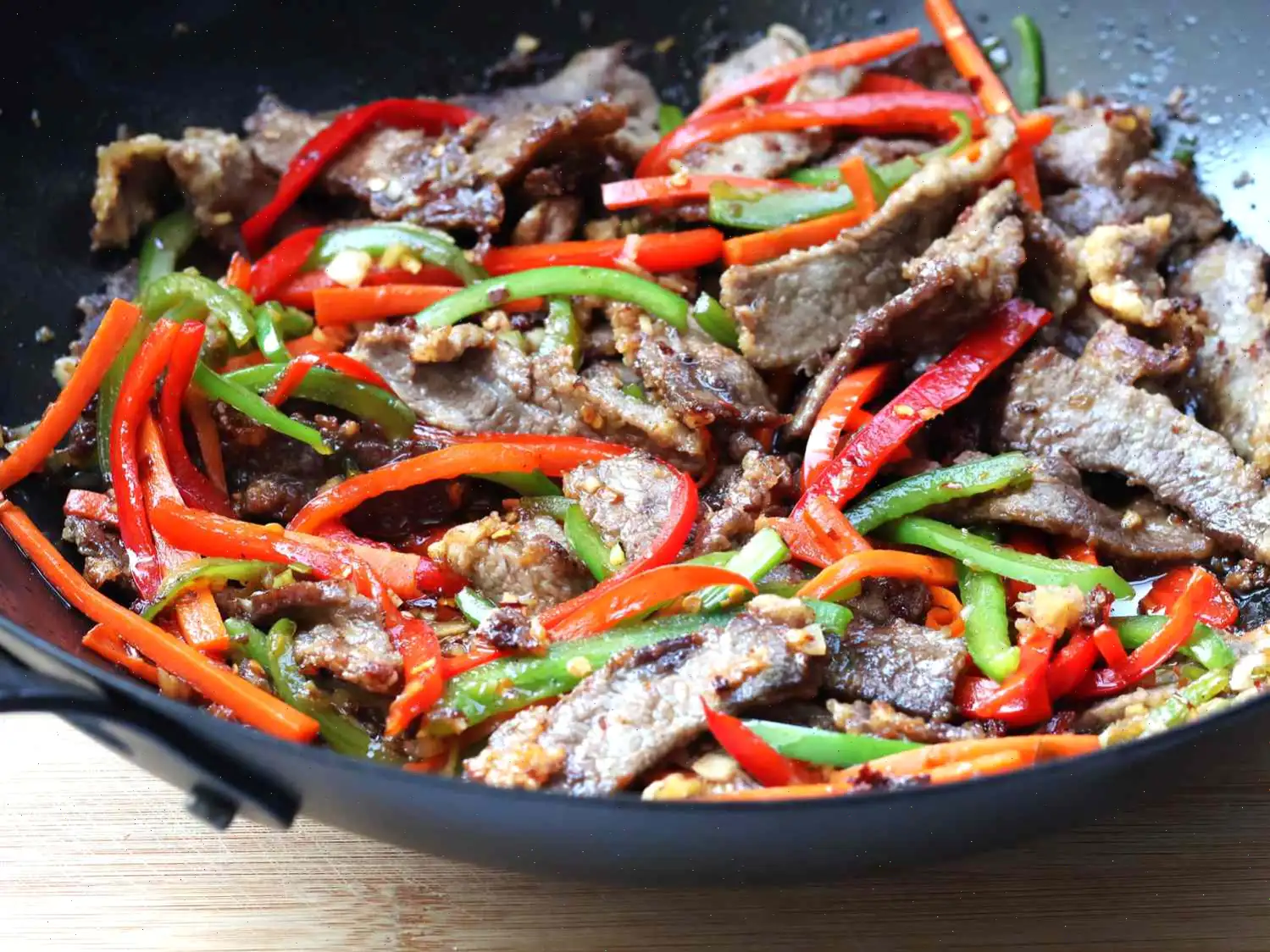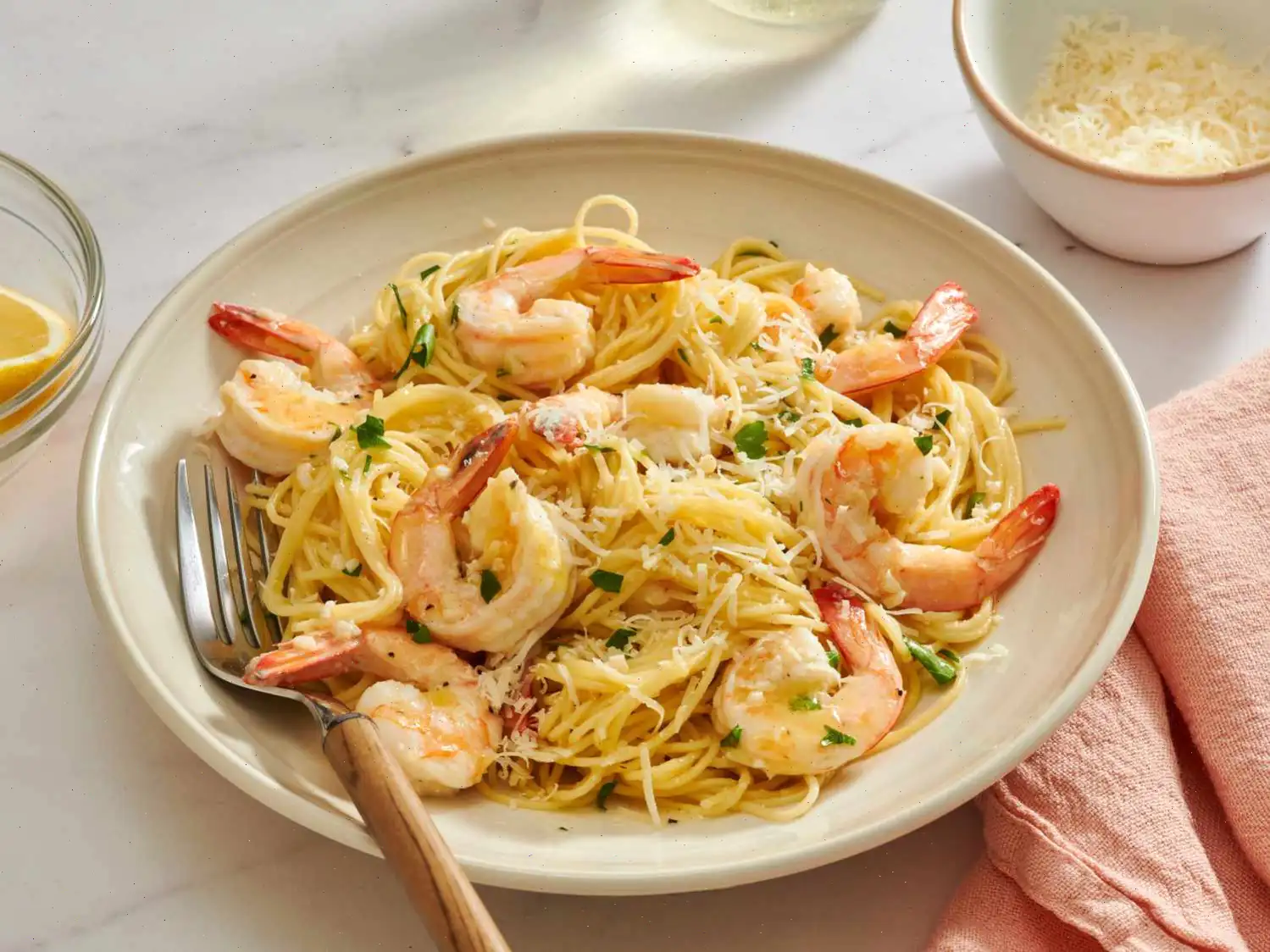
Sauerbraten I Recipe
Ingredients
This recipe was developed at its original yield. Ingredient amounts are automatically adjusted, but cooking times and steps remain unchanged. Note that not all recipes scale perfectly. Original recipe (1X) yields 6 servings:
- 2 cups cider vinegar
- 2 cups water
- cup brown sugar
- teaspoon ground cloves
- teaspoon ground allspice
- 1 tablespoon salt
- teaspoon ground black pepper
- 6 black peppercorns
- 1 bay leaf
- 2 onions, diced
- 3 carrots, chopped
- 2 stalks celery, chopped
- 4 pounds rump roast
- 2 tablespoons vegetable oil
- 1 cup sour cream
Directions
Step 1: In a large saucepan over medium heat, combine cider vinegar, water, brown sugar, cloves, allspice, salt, pepper, peppercorns, bay leaf, onion, carrot, and celery. Heat the mixture, stirring occasionally, until bubbles form around the edges, but do not allow it to boil.
Step 2: Using a sharp knife, poke deep holes into the roast. Place it in a non-metal bowl and pour the vinegar mixture over the roast. Cover the bowl and refrigerate for five days, turning the roast once daily to ensure the meat marinates evenly.
Step 3: After five days, remove the roast from the marinade. Pat the roast dry with paper towels. Discard the bay leaf and peppercorns from the marinade. Strain the liquid from the vegetables, keeping both the liquid and the vegetables separate for later use.
Step 4: In a Dutch oven, heat vegetable oil over medium-high heat. Quickly sear all sides of the roast for about 1 to 2 minutes per side, until a golden-brown crust forms.
Step 5: Reduce the heat to low, and add the reserved vegetables and 1 cup of the strained vinegar liquid to the Dutch oven. Cover and simmer the roast for 1 hours, checking occasionally and adding more vinegar liquid if necessary to maintain the cooking moisture.
Step 6: After 1 hours, remove the roast from the pan and allow it to cool slightly. Slice the roast into thin pieces and return them to the liquid in the Dutch oven. Cover and simmer for an additional 30 minutes to let the flavors meld.
Step 7: Remove the sliced roast from the liquid and transfer to a serving platter. Stir sour cream into the heated liquid, making sure it blends well. Heat the sauce through, but do not let it come to a boil.
Step 8: Pour the sour cream sauce over the sliced meat and serve immediately. Enjoy!
Nutrition Facts (per serving)
| Calories | Fat | Carbs | Protein |
|---|---|---|---|
| 941 | 61g | 22g | 69g |
Nutrition Breakdown
- Total Fat: 61g (79% Daily Value)
- Saturated Fat: 25g (125% Daily Value)
- Cholesterol: 224mg (75% Daily Value)
- Sodium: 1457mg (63% Daily Value)
- Total Carbohydrates: 22g (8% Daily Value)
- Dietary Fiber: 2g (8% Daily Value)
- Total Sugars: 15g
- Protein: 69g (138% Daily Value)
- Vitamin C: 5mg (6% Daily Value)
- Calcium: 107mg (8% Daily Value)
- Iron: 6mg (31% Daily Value)
- Potassium: 1440mg (31% Daily Value)
* Percent Daily Values are based on a 2,000-calorie diet. Your daily values may be higher or lower depending on your calorie needs.
** Nutrient information is not available for all ingredients. Amount is based on available nutrient data.

Origin of Sauerbraten
Sauerbraten, often referred to as the "national dish" of Germany, has deep historical roots in the countrys culinary traditions. The dish dates back centuries and was originally a way to preserve meat. The word "Sauerbraten" translates to "sour roast," which reflects the marinade that features vinegar as a key ingredient. The tradition of marinating meat in a sour liquid is believed to have originated in the Middle Ages, when people sought to preserve meats before refrigeration was available. It was common practice to marinate tougher cuts of meat in vinegar or wine to tenderize them, resulting in the deliciously tangy flavor that defines Sauerbraten today. Over time, various regions in Germany began to add their own twists to the recipe, contributing to the diversity of preparations seen across the country.
Regional Variations
Sauerbraten is popular across Germany, but regional variations abound. The most well-known versions include those from Rhineland, Franconia, and Swabia. Rhineland Sauerbraten often uses a combination of vinegar and wine for the marinade, while Franconian versions might include the addition of gingerbread or gingersnaps in the sauce, providing a sweeter note to balance the acidity. In Swabia, the roast is typically served with potato dumplings and a rich, creamy sauce. While the basic concept of marinating a tough cut of meat remains consistent, the specific ingredients and accompanying sides vary from region to region, giving the dish a rich diversity of flavors.
What Makes Sauerbraten Unique
Sauerbraten stands apart from similar dishes like pot roast or beef stew due to its unique method of preparation. The most distinguishing feature is the marination process, where the meat is soaked for several days in a mixture of vinegar, water, and spices before being braised. This results in a tender, flavorful roast with a pronounced tang from the vinegar. Other similar dishes, such as pot roast, may be cooked with a more straightforward approachslow-cooked in broth without the complex marinade. The inclusion of sour cream in the sauce, another hallmark of Sauerbraten, adds a creamy richness that balances the tangy vinegar, giving the dish a depth of flavor not commonly found in other meat-based stews or roasts.
Where Sauerbraten is Typically Served
Sauerbraten is a traditional German comfort food often reserved for special occasions such as holidays and family gatherings. It is commonly served at festive meals, especially during Christmas and Easter, and is a popular dish in beer halls and restaurants across Germany. Internationally, you can find it in German restaurants and eateries specializing in European cuisine. While the dish is hearty enough to be served on its own, it is most frequently accompanied by sides like potato dumplings, spaetzle, red cabbage, or boiled potatoes. The rich, tangy gravy pairs perfectly with these starches, making for a satisfying and comforting meal.
Fun Facts About Sauerbraten
- Sauerbraten is often said to be better the next day, as the flavors have more time to meld together.- In the Rhineland region, it is common to add wine to the marinade for a more complex flavor profile.- Some variations of the dish include adding raisins, which provide a sweet contrast to the sour marinade.- The practice of marinating meat in vinegar dates back to the Roman Empire, though it wasnt until the Middle Ages that this technique became widely used for beef.- Sauerbraten is traditionally prepared with tougher cuts of beef, but today it can be made with other meats like pork, lamb, or even venison, depending on regional preferences.
FAQ about Sauerbraten I Recipe
Comments
William Hill
03/03/2023 05:08:48 AM
This dish was incredibly tasty! I marinated it in a sealed zip-close bag for 4 days, added plenty of onions, and omitted other vegetables. On the 5th day, I transferred it to the crockpot on low for 8 hours. Once the meat was tender and falling apart, I took it out of the pot. I then mixed in the remaining juices with 3/4 cup of crushed gingersnaps, 1/4 cup of brown sugar, and 1 cup of sour cream to make a classic gravy. Absolutely delicious!
Linda Rivera
12/14/2022 09:16:33 AM
I halved this recipe to make a meal for myself and my German boyfriend. His mother usually doesn't make this dish the traditional way like his grandmother did, so I wanted to create something that would remind him of home. I was grateful for all the helpful comments on this recipe. After marinating the roast for 5 days, I browned it in bacon drippings before putting it in the crock pot with the liquid on low heat. Since it was a smaller 2lb roast, it was ready in about 4.5 hours. After removing the veggies, I added 1/2 cup of gingersnaps to the liquid and simmered for an additional 30 minutes. Finally, I stirred in 3 tablespoons of sour cream to finish the delicious gravy. I served it with red cabbage and potato dumplings. My boyfriend loved it and said it tasted just like his grandmother's recipe. Thank you!
Timothy Hill
04/15/2025 06:30:30 AM
Not impressed. The dish was overly sour, to the point of being unpleasant. I attempted to balance it out by incorporating ginger snaps into the gravy, but it remained too sour. Following a recommendation, I tried adding sour cream and brown sugar to the gravy post-meal, and it greatly improved the flavor. Despite this tweak, I do not plan on making this recipe again.
Jerry Allen
02/23/2023 04:48:20 PM
Not the best experience. The dish was overwhelmingly sour, to the point where adding ginger snaps to the gravy didn't balance it out. Following a recommendation, I tried mixing in sour cream and brown sugar after serving, which significantly improved the taste. Despite the improvement, I don't plan on making this dish again.
Janet Thompson
08/09/2023 02:16:42 PM
Divine
Adam Mitchell
11/05/2022 08:48:05 AM
I tried out the recipe and it turned out wonderfully tender. I paired it with spaetzle, and I'm excited to experiment by adding ginger snaps next time.
Susan Hall
12/11/2024 03:23:08 AM
Very similar to Grandma's recipe!








